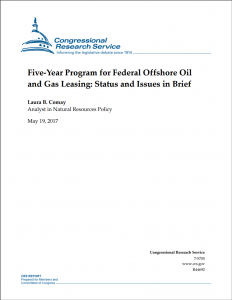Full Title: Five-Year Program for Federal Offshore Oil and Gas Leasing: Status and Issues in Brief
Author(s): Laura B. Comay
Publisher(s): Congressional Research Service
Publication Date: May 1, 2017
Full Text: Download Resource
Description (excerpt):
Under the Outer Continental Shelf Lands Act (OCSLA), as amended,1 the Bureau of Ocean Energy Management (BOEM) must prepare and maintain forward-looking five-year plans—referred to by BOEM as five-year programs—for proposed public oil and gas lease sales on the U.S. outer continental shelf (OCS). During the Obama Administration, BOEM released a leasing program for the period from mid-2017 through mid-2022.2 The program schedules 11 lease sales on the OCS during the five-year period: 10 in the Gulf of Mexico region (occurring twice each year), 1 in the Cook Inlet planning area of the Alaska region (scheduled for 2021), and none in the Atlantic or Pacific regions. Three sales proposed in earlier versions of the program—one in the Atlantic and two off Alaska—were not ultimately included in the program. On April 28, 2017, President Trump issued an executive order directing the Secretary of the Interior to review and consider revising the 2017-2022 program.
The leasing decisions in BOEM’s five-year programs may affect the economy and environment of individual coastal states and of the nation as a whole. Accordingly, Congress typically has been actively involved in planning and oversight of the five-year programs. The following discussion summarizes developments in the 2017-2022 program and considers selected congressional issues and actions related to the program. The history, legal and economic framework, and process for developing the program are discussed in CRS Report R44504, The Bureau of Ocean Energy Management’s Five-Year Program for Offshore Oil and Gas Leasing: History and Final Program for 2017-2022.
The 115th Congress could influence the five-year program by enacting legislation to alter the program, as well as by conducting oversight. For example, Members could enact legislation to add new sales to the program (e.g., H.R. 1756, S. 665, and S. 883) or to remove scheduled sales. Congress also could end leasing moratoria imposed by Congress or the President on some offshore areas, and could mandate sales in these previously unavailable areas. 4 Alternatively, Congress could impose leasing moratoria on new areas; for example, H.R. 169, H.R. 728, H.R. 731, H.R. 2002, H.R. 2242, H.R. 2252, H.R. 2272, S. 31, S. 74, S. 750, and S. 999 would prohibit oil and gas leasing (or extend existing moratoria) in various parts of the OCS.
The options for the Administration to alter the finalized five-year program are more constrained than those of Congress. The Secretary of the Interior’s review of the 2017-2022 leasing program under President Trump’s executive order must adhere to the program development process required by the OCSLA, 5 which includes requirements for analysis, public input, and environmental review under the National Environmental Policy Act. 6 The process typically takes
